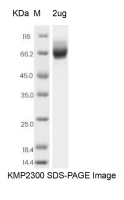Human CD137 Protein, Fc Tag
-
产品编号
KMP2300
-
别名
肿瘤坏死因子超家族受体9, CD137, ILA
-
规格
- 50ug
- 100ug
- 200ug
| Alias | 肿瘤坏死因子超家族受体9, CD137, ILA |
| Catalog Number | KMP2300 |
| Product Description | The Human CD137 Protein(KMP2300) is produced in HEK293 Cells and the target gene encoding Leu24-Gln186 is expressed with a Fc tag at the C-terminus. |
| Molecular Name | CD137 |
| Species | Human |
| Host | HEK293 Cells |
| Size | 50ug, 100ug, 200ug |
| Purity | >95% as determined by SDS-PAGE |
| Purification | Affinity purification |
| Endotoxin | <1.0 EU/ug determined by the LAL method |
| Formulation | PBS, pH7.4 |
| Background | Tumor necrosis factor receptor superfamily member 9(TNFRSF9), also known as CD137 and 4-1BB, is an inducible T cell surface protein belonging to the tumor necrosis factor receptor superfamily. It is a single-pass type I membrane protein which contains 4 TNFR-Cys repeats. The human and mouse proteins share 60% amino acid sequence identity. CD137 is expressed by mesenchymal cells, including endothelial cells, chondrocytes, and cells of the central nervous system. CD137 is also broadly expressed by cells of the human immune system, is broadly expressed by cells of the human immune system, including activated CD8+ and CD4+ T cells, activated natural killer(NK) cells, follicular dendritic cells(FDCs) and monocytes. CD137 has diverse roles in the immune response, the one key function is to promote the survival of both T cells and dendritic cells by binding the cognate ligand CD137L(4-1BBL). |
| SDS-PAGE |  |
| Predicted Molecular Weight | 17.37 kDa |
| Storage Condition | Aliquot and store at -20℃ to -80℃. Avoid repeated freezing and thawing cycles. |
| Shipping Condition | In general, the proteins are provided as lyophilized powder which are shipped at ambient temperature. They are shipped out in dry ice if supplied in liquid form. |
| Uniprot ID | Q07011 |
| References | J. Allergy Clin. Immunol. 144:574-583 (2019) |
| Function | Receptor for TNFSF9/4-1BBL. Conveys a signal that enhances CD8+ T-cell survival, cytotoxicity, and mitochondrial activity, thereby promoting immunity against viruses and tumors (Probable). |





 0
0
